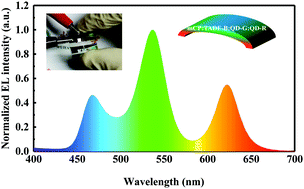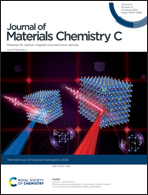Organic and quantum-dot hybrid white LEDs using a narrow bandwidth blue TADF emitter†
Abstract
White electroluminescence is of particular importance for high resolution full-color flexible displays which use a down-conversion scheme to generate individual red, green and blue emissions from color filters. Quantum dot (QD) light emitting diodes possess ultrahigh brightness and considerably narrow full-width-half-maximum (FWHM) spectra. Nevertheless, inefficient blue QDs limit the overall device performances. Herein, we introduced a boron-based blue thermally activated delayed fluorescent compound and utilized the host–guest system to construct solution-processed white devices. Red and green QDs combined with the blue emitter enable a feasible design of the flexible white devices with sharp peaks and thus intrinsically wide color gamuts. The proof-of-concept hybrid white devices with a single emissive layer exhibited external quantum efficiencies of 6.9% (on a rigid substrate) and 2.3% (on a flexible substrate). The color mixing effect and energy transfer among the lumophores were exemplified with three sharp peaks at around 464, 538 and 622 nm, respectively accompanied with the corresponding FWHM of 30, 34 and 31 nm of each component.

- This article is part of the themed collection: Journal of Materials Chemistry C Emerging Investigators


 Please wait while we load your content...
Please wait while we load your content...